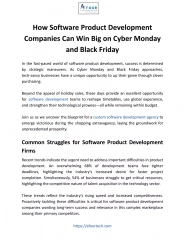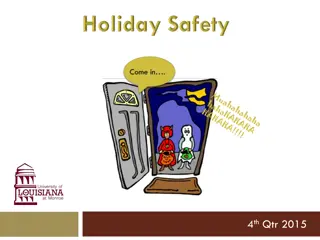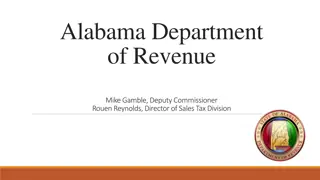Strategies for Retailers in the 2020 Holiday Season
The 2020 holiday season is crucial for both retailers and Americans seeking solace from the pandemic. Recent sales data hint at potential opportunities, with e-commerce playing a pivotal role. The back-to-school season will offer early insights, and past brick-and-mortar holiday results may not fully guide planning. Innovative strategies and online presence will be key for retailers to navigate uncertainties ahead.
Download Presentation

Please find below an Image/Link to download the presentation.
The content on the website is provided AS IS for your information and personal use only. It may not be sold, licensed, or shared on other websites without obtaining consent from the author.If you encounter any issues during the download, it is possible that the publisher has removed the file from their server.
You are allowed to download the files provided on this website for personal or commercial use, subject to the condition that they are used lawfully. All files are the property of their respective owners.
The content on the website is provided AS IS for your information and personal use only. It may not be sold, licensed, or shared on other websites without obtaining consent from the author.
E N D
Presentation Transcript
The Most Important Holiday Season for Most of Us The 2020 holiday season will not only be extremely important for retailers, but also all Americans, as they search for some solace from the pandemic and a return to lives of normalcy. Although it is quite difficult to forecast the state of the pandemic for the last three months of the year, the clearest indications as of the writing of this report is it probably won t change much. It s a unique situation requiring all retailers to plan farther in advance and with more creative thinking, providing you with an opportunity to step forward and assist them as a trusted advisor.
Recent Retail Sales Are a Good Starting Point Recent retail sales data from the US Census Bureau provides some good news, although the return of earlier restrictions in many states and stores during July may limit future improvements in retail sales. June 2020 s total retail sales increased significantly from April, or 29.3%, and a respectable +7.5% from May, as well as an unexpected +1.1% from June 2019. Keep in mind most retailers had to climb from the very big holes of March and April. June sales at clothing & clothing accessories stores increased 105.1% from May, but were 23.2% less than June 2019. Only sporting goods, hobby, musical instrument and book stores June 2020 sales increased from May (+26.5%) and June 2019 (+20.6%).
E-commerce Keeps Retailers Heads Above Water Q1 2020 e-commerce sales increased 14.5% YOY; however, by mid-March, e-commerce sales increased 40% YOY for the period March 13 March 24. Average daily online grocery sales increased 100% from the March 1 11 period to the March 13 15 period. The e-commerce surge didn t abate during April, increasing 49% for April 1 23, compared to March 1 11, with online grocery sales increasing another 110%, according to Digital Commerce 360. Mastercard Spending Pulse for May e-commerce sales, although some sectors performed much better than others: Home improvement +149% and footwear +64%, but department stores -15% and jewelry -33%. reported a 93% increase
The Back-to-School Factor The 2020 back-to-school shopping season (the second-largest annually) will be an important and early indication of what may occur during the holidays. Many school districts have not yet decided whether they will open during the fall. Despite all the uncertainties, the National Retail Federation forecasted during mid-July a record- setting year, with parents of K 12 students spending a total of $33.9 billion and spending for college students totaling $67.7 billion. K 12 shoppers are expected to increase their online purchases from 49% for 2019 to 55% for 2020. Interestingly, online shopping for college students will decline slightly, from 45% to 43%, but still a substantial percentage.
2019 Holiday Brick- and-Mortar Results For the 2020 holiday shopping season, last year s normal results may have less bearing on what will occur this year and how national and local retailers must prepare for a bigger list of unknowns. For example, many people may not want to be in crowded stores if the pandemic hasn t abated appreciably, but the opposite could occur with significant decreases in cases, hospitalizations and deaths. Mastercard SpendingPulse in total 2019 holiday sales (excluding light-vehicles) while the US Census Bureau s increase was slightly more at 3.6%, or a total of $1.15 trillion (excluding light- vehicles and auto parts). reported a 3.4% increase
What 2019 Holiday In-Store Shopping Means for 2020 Extrapolating the possible results for the 2020 holiday shopping season is extremely difficult given the many uncertainties. Department stores, however, are likely to face continued difficulties considering the many bankruptcies and store closings during the first half of 2020. Q4 2019 spending at food services and drinking places increased 4.9%, but if limitations on the number of patrons allowed in these establishments are similar to the early-pandemic period, then it s unlikely restaurants and bars will repeat their 2019 performance. The same scenario could adversely affect Small Business Saturday 2020 (November 28), which set a record of $19.6 billion spent at independent retailers and restaurants during 2019.
Online Shopping Outshines the Christmas Lights 2019 holiday online sales increased 18.8%, accounting for 14.6% of all sales. While in-stores sales were tepid at best, online sales increased 17% for specialty apparel, +8.8% for jewelry, +10.7% for electronics and +6.9% for department stores. Although 142.2 million consumers shopped online during the 2019 holiday season, it s likely that number will increase appreciably for 2020, regardless, or because, of the condition of the pandemic during Q4 2020. Cyber Monday and Black Friday 2019 had the largest increases in online sales, at 19.7% and 19.6%, respectively; however, Cyber Monday sales ($9.42 billion) were almost $2 billion more than Black Friday ($7.43 billion).
More 2019 Online Shopping Trends Of the $4.21 billion spent on Thanksgiving Day, 44.9% was initiated from smartphones, a 24.4% increase from 2018. Similarly, for Cyber Monday, almost one-third ($3.1 billion) of the $9.42 billion total spent online was from smartphones, an all-time record. Maybe, the two Cyber Monday 2019 statistics most crucial for 2020 is the 40.9% YOY increase of consumers use of BOPIS (buy online pick up in-store) and the 20% of consumers who said they were more likely to buy from a retailer offering the service. Purchases via smartphones during Small Business Saturday 2019 for retailers with an e-commerce presence, including the mobile channel, increased 22% from 2018 and represented 41.2% of all online sales that day.
Know Your Target Age Groups! Misperceptions of various age groups/generations holiday shopping behaviors are primary reasons brands and retailers fail to maximize not only sales, but also establish long-term relationships with consumers. For example, research from The National Retail Federation (NRF) for the 2019 holiday shopping season found shoppers younger than 25 would probably shop more in stores than Millennials and Baby Boomers. A Business Insider survey found Gen Zers was the only age group which would rather shop during Black Friday than Cyber Monday. Conversely, more Baby Boomers (61.3%) were attracted to Cyber Monday shopping than all their younger counterparts.
The Holiday Timeline Is Critical Another misperception is most holiday shopping occurs prior to and including the 5-Day Thanksgiving Weekend. The NRF reported 39% of the consumers it surveyed bought their last gift prior to Wednesday, December 18, but 56% during the week of Christmas. For the 2019 holiday season, Friday, December 20 (12%) and Saturday, December 21 (13%) were the two days when the most shopping occurred after December 18. Even 4% of late-holiday shopping occurred the day after Christmas. Adobe Analytics collected and compared online shopping data from big and small cities and discovered shoppers in small cities spent more per order, generated an average order value almost as much as big-city dwellers and delivered essentially the same share of smartphone orders.
2020 Forecast: Mission Impossible One of the earliest forecasts for the 2020 holiday shopping season is courtesy of Radial. Its mid-summer survey found a majority of respondents were planning to spend as much for 2020 holiday shopping as previous years. The troubling news for brick-and-mortar retailers (especially those without an online presence, or a basic presence) is 60% of consumers said they would shop less in stores, and 66% expected to spend more online. Another interesting finding from the Radial survey is 41% of respondents didn t think they would start shopping earlier than previous years. Brands and retailers will have the same amount of time to prepare.
The Clock Is Ticking It s clear from the contents of this Special Report that people expect to experience and need like no recent year a joyous holiday season and they plan to shop and buy, accordingly. Retailers biggest challenges are to prepare not only their advertising strategies and buys, but also offer the channels (in-store, online, mobile, etc.) and services (BOPIS, a curbside service, timely deliveries, etc.) today s pandemic-hardened consumers view as norms. Undoubtedly, many savvy consumers will start shopping as early as September and October, but a large share of their dollars are spent during the 5-Day Thanksgiving Weekend, and a majority just before Christmas.
More Strategic Considerations The 2020 holiday season will be of fewer days than many past years, but 2 days more than 2019, or 28 and 26 days, respectively. Thanksgiving is a later date, November 26, and Christmas Day is a Friday. Local retailers may want to concentrate even more ad dollars and promotions to maximize Small Business Saturday 2020, but they will also have to be nimble to adjust their in-store health and safety protocols as the pandemic continues or abates. If a large portion of the population must temper their holiday shopping because of the adverse financial effects of the pandemic, then promotions and low prices may be even more important than previous years.





![[✔PDF✔⚡] ✔DOWNLOAD✔ Blank Recipe Book For Holiday Season: My Holiday Recipe](/thumb/68037/pdf-download-blank-recipe-book-for-holiday-season-my-holiday-recipe.jpg)

















